
When Dell Children’s Medical Center of Central Texas (DCMCCT) in Austin opens its doors this month, medical professionals as well as pediatric and adolescent patients will have reason to celebrate. That’s because the $175 million, 480,000-sq-ft hospital, which is located on approximately 32 acres of the old Austin Mueller airport site, is more than three times the size of the existing Children’s Hospital. In addition, the four-story, full service pediatric facility will feature 30 more beds, a larger emergency center, and numerous new lab areas to care for Texas’s smallest patients.
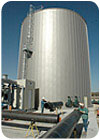
Figure 1. An
880,000-gal chilled water TES tank is sized to provide four hours of peak
shaving as well as operational flexibility and increased redundancy.
DCMCCT is one of the first hospitals in Texas to meet its own energy requirements with an on-site energy system, ensuring it remains fully operational during a power outage. The energy center features a natural gas-fired combustion turbine, a heat recovery steam generator, and a 900-ton absorption chiller. The system is designed to base load the absorption chiller in combination with a packaged electric centrifugal chiller plant and an 8,000 ton-hr TES tank in order to meet the hospital’s chilled water cooling loads.
The innovative design has resulted in impressive energy savings and has also made the hospital eligible for designation as a LEED® Platinum facility, the highest LEED certification attainable.
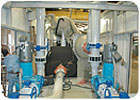
Figure 2. Packaged
1,500-ton electrical centrifugal chiller plant being fabricated at Turbine Air
Systems plant in Houston.
Need for Independence
When Seton Healthcare, the operating entity of DCMCCT, decided to build the new hospital, a budget of approximately $8 million was set aside for traditional heating and cooling systems, which would include boilers, chillers, and back-up generators. That arrangement changed early in the decision-making process when Seton decided its $8 million might go farther if the energy plant were outsourced to the local municipal utility. In addition, hospital personnel wanted to focus on their core business ---- health care. They were comfortable leaving the decisions regarding energy to Austin Energy.Hospitals normally buy power from a central generation plant, which is often located miles away. In many situations, two independent feeds are provided by the utility, so if one utility feeder fails, the other can be used as a backup. DCMCCT wanted to be different in that it wanted the flexibility to be grid independent. In case of a power failure, it didn’t want to just have on-site emergency generation to provide for life safety needs; it wanted 100% of the hospital to be up and running. Such capability would also establish the facility as a neighborhood sanctuary in time of emergency.
Another reason why DCMCCT wanted reliable, high-quality power is that many of its functions are digital. If power is lost for any period of time, all health care delivery is essentially stopped. This simply cannot happen in a hospital that has converted to fully automated medical records, RFID/barcode scan drug delivery, computerized physician order entry, etc.
Ed Mardiat, DBIA, principal, Burns & McDonnell of Kansas City, acknowledged that this shift in thinking about reliable power occurred as a result of recent tragedies in the U.S. “One of the lessons learned from 9/11 was that in time of crisis, whether the crisis is a terrorist attack, natural disaster, or a major blackout such as the one that occurred in the Northeast, it is imperative that critical care facilities have the ability to have 100% of the facilities systems up and running.”
For all these reasons, DCMCCT needed an energy center to provide 100% of its electrical, steam, and chilled water requirements.
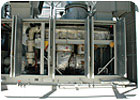
Figure 3. A
recuperated combustion turbine is the heart of the CHP system. It provides 4.3
mW of on-site generation with a simple cycle heat rate of 38% while producing
less than 5 ppm NOx emissions.
Hale and Hearty Hybrid
The energy center is part of a district cooling loop for DCMCCT and the rest of the 32-acre site, which will eventually include a Ronald McDonald House, medical office buildings, and a new University of Texas research campus. While the energy center will provide chilled water or steam to these other facilities, its primary electrical customer is DCMCCT; in the event of a grid outage, the hospital will be the only facility that receives electrical energy from the plant.The hybrid CHP energy center is basically a packaged, modular system that uses standard, pre-manufactured components. The modular system was designed to reduce the custom engineering, planning, and project lead time that is standard for most CHP systems. In addition, the modular design will make plant expansions easier in the future, as the Mueller campus develops.
As Mardiat noted, “All of the pipe headers have been designed to meet the future load, and essentially there are connection points already provided. When they need to add the next packaged chiller plant, it will be dropped in, the valves opened, and the system will be turned on and integrated into the rest of the plant.”
At the heart of the CHP module is a Solar Turbines 4.6 MW Mercury 50 natural gas-fired combustion turbine, which provides 100% of the hospital’s power needs. This combustion turbine has a 38% simple cycle heat rate, which means it’s more efficient than coal or simple cycle natural gas turbines.
The advanced turbine technology features low CO emissions and will reduce nitrogen oxide (NOx) emissions to less than 5 ppm, allowing the system to meet the very stringent Texas Commission on Environmental Quality emission standards without any additional exhaust treatment equipment. The turbine is completely pre-engineered and prepackaged and is installed outdoors, along with the other equipment in the energy center.
Since the turbine’s waste heat is recaptured by a heat recovery steam generator (HRSG), the system is more than 75% efficient, as opposed to a central generation system’s efficiency rate of 40% to 55%. Supplemental duct firing essentially doubles the steam output of the HRSG to 28,000 lb/hr, and a packaged standby boiler is capable of producing 20,000 lb/hr. Steam from the HRSG serves 100% of the hospital’s process and space heating needs, while also providing fuel input to a 900-ton heat recovery absorption chiller.
There are no heat exchangers to serve as barriers between the energy plant and the hospital; what is produced by the chilled water and steam equipment goes directly to the facility.
Heat recovery and economizers are just some of the energy-efficient features utilized in the energy center. VSDs were installed on all of the pumps, including the TES tank and primary variable flow system, and all motors over 25 hp have VSDs or soft-start starters.
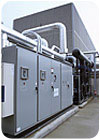
Figure 4. VFDs
and the primary chilled water distribution pumps modules are examples of
packaged systems used throughout the energy center.
Chilling Out
Located adjacent to the Trane “Horizon” two-stage steam absorption chiller is a packaged chiller plant, which includes a Trane 1,500-ton duplex electrical centrifugal chiller, chilled water and cooling water pumps, cooling towers, and motor control center. The packaged chiller delivers additional chilled water above and beyond what the CHP would deliver as its base load, and it also adds reliability and flexibility in the operation of the energy center. Both chillers were weatherized for outdoor operation.Another significant feature of the CHP energy center is the TES tank. The 880,000-gal Chicago Bridge and Iron tank is sized for 8,000 ton-hrs of storage capacity, or enough time to defer from running the electrical centrifugal chiller during the peak energy times of the day. The thermal storage tank also provides increased redundancy and reliability during non-peak periods, by allowing the stored chilled water to be used as backup to the packaged chiller plant and the absorption chiller. In addition, the tank can be used for fire protection water in the event it is required.
The energy center was commissioned and up and running more than a year before the hospital opened, and the TES tank was especially handy to have in operation during this time period, said Mardiat. “The real beauty of the tank was that the actual loads required before the hospital opened were pretty small, usually around 300 tons of cooling. If you tried to deliver that 300 tons with a 1,500-ton chiller, it would be very inefficient, difficult to control, and it would also be very hard on the equipment.”
Instead, the duplex chiller was operated long enough to charge the TES tank to its full 8,000 ton-hrs of capacity, then the chiller was turned off. The TES tank discharged over the course of several days, which saved a lot of energy and wear and tear on the electric centrifugal chiller package.
A chilled water TES tank was chosen over an ice storage system, because if the latter were used, a third type of chiller would have been needed. “We already had an electric centrifugal and an absorption chiller, but in order to make the ice, we would’ve needed a glycol chiller. Basically, the chilled water storage option gives us the ability to deliver the 40°F chilled water without having to use additional technology,” said Mardiat.
While space around the CHP energy center is at a premium, there was no problem installing the aboveground tank immediately adjacent to the plant. In fact, the tank blends into the plant very well and just received the “Steel Tank of the Year - Special Storage” award from the Steel Tank Institute and Steel Fabricators Association.
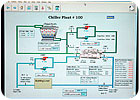
Figure 5.
PLCs were used as the primary digital controller, and this is the local
man/machine interface (MMI) display located in the packaged chiller electric
centrifugal chiller plant.
Controls and LEED®
As can be expected, a robust controls system was required to manage the substantial amount of equipment in the energy center. As Mardiat noted, “A big part of this project was the overall system integration of all these pre-engineered and modular packages. This was all done through PLC-based controls, and by communicating with man-machine interfaces on each individual package and skid. All of those points were brought back to the central control room and managed by the digital control system for the plant.”The controls integration system has an array of data sensors that monitor and record the system peak inputs and outputs as well as intermediate conditions. The controls integration system can monitor and record electrical and thermal data for all components of the system: the emergency standby generator, natural gas compressor, combustion turbine generator, HRSG, packaged boiler, electric centrifugal and absorption chiller, cooling tower, TES tank, and auxiliaries. Austin Energy operates and monitors the plant from a central operations center.
While Austin Energy operates and maintains the energy plant, the utility has a partnered relationship with the hospital engineering staff. For example, the two entities share data on key points, such as DT delivery temperatures; however, Austin Energy cannot control the tertiary pumps in the building, nor can the hospital control the distribution pumps in the energy plant. It’s an unusual arrangement that Mardiat said is becoming more common.
Another exciting aspect of this project is that the energy plant is an integral component of the DCMCCT’s application to become the first LEED Platinum hospital in the world. That made Mardiat’s job a little tougher, because, “This is the first project that we are aware of in the nation that was able to take advantage of the new LEED recognition for district cooling, as well as CHP. That was a challenge, because when the project started, we didn’t think that this plant was going to be integrated into the LEED effort at the hospital, but at the end of the day it was. That was pretty significant.”
Final LEED certification is still a ways off, but Mardiat noted that all points are still on track for platinum certification. And more changes are still to come. Subsequent facilities will likely be built over the next 10 years, requiring another turbine as well as another heat recovery steam generator and absorption chiller. The goal will remain as it is now, though: The entire site will continue to be grid independent, so that future expansion of the health care site will also benefit from the on-site energy production facility. ES

